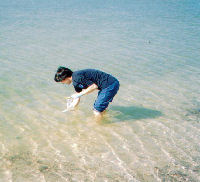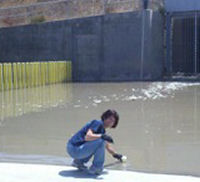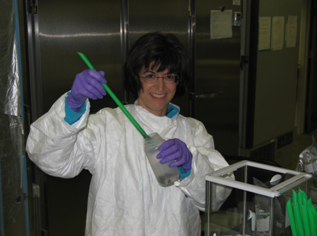Kelly D. Goodwin, Ph.D. |
|
|
|
Curriculum Vitae: Research Interests: Selected Awards: NOAA Technology Transfer Award, 2012 NOAA Certificates of Recognition or Appreciation, 2012,2010,2008 Publications: Performance evaluation of canine-associated Bacterioidales assays in a multi-laboratory comparison study. A. Schriewer, C.D. Sinigallinao, K.D. Goodwin, A. Cox, D. Wanless, J. Bartkowiak, D.L. Ebentier, K.T. Hanley, J. Ervin, L.A. Deering, O.C. Shanks, L.A. Peed, W.G. Meijer, J. Griffith, J. Santo Domingo, J.A. Jay, P.A. Holden, and S. Wuertz. Water Research, http://dx.doi.org/10.1016/j.watres.2013.03.062 (2013). Recommendations following a multi-laboratory comparison of microbial source tracking methods. J. Stewart,J., A.B. Boehm, E.A. Dubinsky, T.-T. Fong, K.D. Goodwin, J.F. Griffith, K. Vijayavel, R.T. Noble, O.C. Shanks, and S.B. Weisberg. Water Research, http://dx.doi.org/10.1016/j.watres.2013.04.063 (2013). Multi-laboratory evaluations of the performance of Catellicoccus marimammalium PCR assays developed to target gull fecal sources. C.D. Sinigalliano, J. Ervin, L.C. Van de Werfhorst, D. Wang, D. Wanless, J. Bartkowiak, B. Layton, M. Raith, A.B.B. Schriewer, C. Lee, K. D. Goodwin, J. Lee, A.B. Boehm, R. Noble, P.A. Holden, J. A. Jay, S. Wuertz, M. Byappanhalli, R. Whitman, M.J. Sadowsky, W. G. Meijer, E. Balleste, M. Gourmelon, J.F. Griffith, H. Ryu, and J.W. Santo Domingo. Water Research, http://dx.doi.org/10.1016/j.watres.2013.02.059 (2013). Evaluation of the repeatability and reproducibility of a suite of PCR-based microbial source tracking methods. D.L. Ebentier, K.T. Hanley, Y. Cao, B. Badgley, A. Boehm, J. Ervin, K.D. Goodwin, M. Gourmelon, J. Griffith, P. Holden, C.A. Kelthy, S. Lozach, C. McGhee, L. Peed, M. Raith, M.J. Sadowsky, E. Scott, J. Santo Domingo, C. Sinigalliano, O. Shanks, L.C. Van de Werfhorst, D. Wan, S. Wuertz and J. Jay. Water Research, http://dx.doi.org/10.1016/j.watres.2013.01.060 (2013). A.M. Cox and K.D. Goodwin. Analysis of sample preparation methods for quantitative detection of DNA by molecular assays and marine biosensors. Environmental Pollution Bulletin, http://dx.doi.org/10.1016/j.marpolbul.2013.06.006 (2013). A multi-beach study of Staphylococcus aureus, MRSA, and enterocci in seawater and beach sand. K.D. Goodwin, M. McNay, Y. Cao, D. Ebentier, M. Madison, and J. F. Griffith. Water Research, 46(13): 4195-207. Epub 21-APR-2012. 10.1016/j.watres.2012.04.001 (2012). Occurrence and Persistence of Human Pathogens and Indicator Organisms in beach sands along the California Coast. K. Yamahara, L. Sassoubre, K.D. Goodwin and A. Boehm. Applied and Environmental Microbiology, 78(6):1733-1745 (2012). New USEPA Water Quality Criteria by 2012: Gulf of Mexico Alliance concerns and recommendations. J. Gooch-Moore, K.D. Goodwin, C. Dorsey, R.D. Ellender, J.B. Mott, M. Ornelas, C. Sinigalliano, B. Vincent, D. Whiting. S.H. Wolfe Journal of Water and Health, 9(4), 718-733, http://www.iwaponline.com/jwh/up/wh2011156.htm (2011). Bacterial uptake of atmospheric carbon tetrachloride in bulk aerobic soils. Y. Mendoza, K. Goodwin and J.D. Happell. Applied and Environmental Microbiology, 77(17), 5835-5841 (2011). Pathogen occurrence and distribution in tropical coastal streams as related to fecal indicators and land use. E.J. Viau, K.D. Goodwin, K. Yamahara, L. Sassoubre, B. Layton, Y. Lu and A. Boehm. Water Research, 45(11), 3279-3290 (2011). Boynton-Delray Coastal Water Quality Monitoring Program. T. Carsey, C. Featherstone, K. Goodwin, C. Sinigalliano, J. Stamates, J.-Z. Zhang, J. Proni, J. Bishop, C. Brown, M. Adler, P. Blackwelder, H. Alsayegh. NOAA Technical Report, OAR AOML-39. August 2011. National Oceanic and Atmospheric Administration (2011). Molecular detection of harmful algal blooms (HABs) using locked nucleic acids and bead array technology. M.R. Diaz, J.W. Jacobson, K.D. Goodwin, J.W. Fell, S.A. Dunbar. Limnol. Oceanogr. Methods 8:269-285. DOI: 10:4319/lom.2010.8.269 (2010). FACE outfalls survey cruise - October 6-19, 2006. Carsey, T.P., H. Casanova, C. Drayer, C. Featherstone, C. Fischer, K. Goodwin, J. Proni, A. Saied, C. Sinigalliano, J. Stamates, P. Swart, and J.-Z. Zhang. NOAA Technical Report, OAR AOML-38, 130 pp. (CD-ROM) (2010). Performance of CHROMagar™ Staph aureus and CHROMagar™ MRSA for detection of Staphylococcus aureus in beach water and sand - comparison of culture, agglutination, and molecular analyses. K.D. Goodwin and M. Pobuda. Water Research, doi:10.1016/j.watres.2009.06.025 (2009). Faecal indicator bacteria enumeration in beach sand: a comparison study of extraction methods in medium to coarse sands. A.B. Boehm, J. Griffith, C. McGee, T.A. Edge, H.M. Solo-Gabriele, R. Whitman, Y. Tsao, M. Getrich, J.A. Jay, D. Ferguson, K.D. Goodwin, C.M. Lee, M. Madison, and S.B. Weisberg. Journal of Applied Microbiology (2009). A preliminary investigation of fecal indicator bacteria, human pathogens, and source tracking markers in beach water and sand. K.D. Goodwin, L. Matragano, D. Wanless, C. Sinigalliano, M.J. LaGier. Environmental Research Journal, 2(4):395-417, pp. 255-277 (2009). A glimpse of the Florida Area Coastal Environment (FACE) program. T. Carsey, K.D. Goodwin, J. Hendee, J.R. Proni, C. Sinigalliano, J. Stewart, J.-Z. Zhang, N. Amornthammarong, J. Craynock, S. Cummings, P. Dammann, C. Featherstone, J. Stamates, K. Sullivan. A Proceedings of the 11th International Coral Reef Symposium, Ft. Lauderdale, Florida, 7-11 July 2008 (2009). Emerging technologies for monitoring recreational waters for bacteria and viruses. K.D. Goodwin and R.W. Litaker. IN: Oceans and Human Health: Risk and Remedies from the Seas. P.J. Walsh, S.L. Smith, W.H. Gerwick, H. Solo-Gabriele, L. Fleming, eds. Academic Press, New York, pp. 381-404, ISBN-13: 978-0123725844 (2008). The future for monitoring. C.J. Palmer, T.D. Bonilla, J.A. Bonilla, S. Elmir, K.D. Goodwin, H.M. Solo Gabriele, and A. Abdelzaher. IN: Oceans and Human Health: Risk and Remedies from the Seas. P.J. Walsh, S.L. Smith, W.H. Gerwick, H. Solo-Gabriele, L. Fleming, eds. Academic Press, New York, pp. 405-429, ISBN-13: 978-0123725844 (2008). The possibility of false negative results hampers the ability to elucidate the relationship between fecal indicator bacteria and human pathogens and source tracking markers in beach water and sand. K.D. Goodwin, L. Matragano, D. Wanless, C. Sinigalliano, M.J. LaGier. IN: Marine Pollution: New Research. T.N. Hofer, ed. Nova Science Publishers, Inc., pp. 255-277, IBSN-13: 978-1604562422 (2008). Salt aerosol and bioaerosol production from a sea-salt aerosol generator. D. Voss, H. Maring, K.D. Goodwin. IN: Marine Pollution: New Research. T.N. Hofer, ed. Nova Science Publishers, Inc., pp. 399-429, IBSN-13: 978-1604562422 (2008). Electrochemical detection of harmful algae and other microbial contaminants in coastal waters using hand-held biosensors. M.J. LaGier, J.W. Fell, and K.D. Goodwin. Marine Pollution Bulletin, doi:10.1016/j.marpolbul.2006.12.017, 54:757-770 (2007). Luminex detection of fecal indicators in river samples, marine recreational water, and beach sand. I.B. Baums, K.D. Goodwin, T. Kiesling, D. Wanless, M. Diaz, and J.W. Fell. Marine Pollution Bulletin, doi:10.1016/j.marpolbul.2006.12.018, 54:521-536 (2007). Brevard County Near Shore Ocean Nutrification Analysis. T.P. Carsey, R. Ferry, K.D. Goodwin, P.B. Ortner, J. Proni, P.K. Swart, J.-Z. Zhang. NOAA Technical Memorandum, in press (2005). Toluene inhibits methyl bromide biodegradation in seawater and isolation of a marine toluene-oxidizer that degrades methyl bromide. K.D. Goodwin, R. Tokarczyk, F.C. Stephens, and E.S. Saltzman, Applied and Environmental Microbiology, 71(7): 3495-3503 (2005). A DNA hybridization assay to identify toxic dinoflagellates in coastal waters: detection of Karenia Brevis in the Rookery Bay National Estuarine Research Reserve. K.D. Goodwin, S.A. Cotton, G. Scorzetti, and J.W. Fell, Harmful Algae, 4: 411-422 (2005). Detection of Karenia brevis by a microtiter plate assay. K.D. Goodwin, G. Scorzetti, S.A. Cotton, T.L. Kiesling, P.B. Ortner, and J.W. Fell. IN: Harmful Algae 2002. Proceedings of the Xth International Conference on Harmful Algae. Steidinger, K.A., Landsberg, J.H. Tomas, C.R., and Vargo, G.A. (Eds.). Florida Fish and Wildlife Conservation Commission and Intergovernmental Oceanographic Commission of UNESCO (2004). Methyl bromide and methyl chloride in the Southern Ocean. Yvon-Lewis, S.A., D.B. King, R. Tokarczyk, K.D. Goodwin, E.S. Saltzman, and J.H. Butler. Journal of Geophysical Research, 109, CO2008, doi:10.1029/2003JC001809 (2004). Methyl chloride and methyl bromide degradation in the Southern Ocean. R. Tokarczyk, K.D. Goodwin, E.S. Saltzman. Geophysical Research Letters, 30(15): OCE 2-1-2-4, doi:10.1029/2003GL017459 (2003). Bacterial degradation of trihalomethanes, Goodwin, K.D. In: M.S. Fram, B.A. Bergamaschi, K.D. Goodwin, R. Fujii, J.F. Clark, Processes affecting the trihalomethane concentrations associated with the subsurface injection, storage, and recovery program in Lancaster, Antelope Valley, California, U.S. Geological Survey Water-Resources Investigations Report, 03-4062, http://water.usgs.gov/pubs/wri/wri034062/ (2003). Halocarbon biogeochemistry. L.G. Miller and K.D. Goodwin (editors). Biogeochemistry, special issue, 60, 92 pages (2002). Water-Quality Monitoring and Studies of the Formation and Fate of Trihalomethanes during the Third Injection, Storage, and Recovery Test at Lancaster, Antelope Valley, California, March 1998 through April 1999. Fram, M.S., J.K. Berghouse, B.A. Bergamaschi, R. Fuji, K.D. Goodwin, and, J.F. Clark. U.S. Geological Survey Open File Report 02-102 (2002). Leisingera methylohalidivorans gen. nov., sp. nov., a marine methylotroph that grows on methyl bromide . J.K. Schaefer, K.D. Goodwin, I.R. McDonald, J.C. Murrell, and R.S. Oremland. International Journal of Systematic and Evolutionary Microbiology, 52: 851-859 (2002). Consumption of tropospheric levels of methyl bromide by C 1 bacteria and comparison to saturation kinetics. K.D. Goodwin, R.K. Varner, P.M. Crill, and R.S. Oremland. Applied and Environmental Microbiology, 67(12): 5437-5443 (2001). Methyl bromide loss rate constants in the North Pacific Ocean. R. Tokarczyk, K.D. Goodwin, E.S. Saltzman. Geophysical Research Letters, 28(23): 4429-4432 (2001). Bacterial degradation of methyl bromide and dibromomethane in natural waters and enrichment cultures. K.D. Goodwin, J.K. Schaefer, and R.S. Oremland. Applied and Environmental Microbiology, 64(12): 4629-4636 (1998). Marine bacterial degradation of brominated methanes. K.D. Goodwin, M. E. Lidstrom, and R.S. Oremland. Environmental Science and Technology, 31(11): 3188-3192 (1997). Production of bromoform and dibromomethane by Giant Kelp: factors affecting release and comparison to anthropogenic bromine sources. K.D. Goodwin, M.E. Lidstrom, and W.J. North. Limnology and Oceanography, 42(8): 1725-1734 (1997). Natural cycles of brominated methanes: macroalgal production and marine microbial degradation of bromoform and dibromomethane. K.D. Goodwin. Ph.D. thesis, California Institute of Technology (1996). Laboratory production of bromoform, methylene bromide, and methyl iodide by macroalgae and distribution in near-shore southern California waters. S.L. Manley, K.D. Goodwin, and W.J. North. Limnology and Oceanography, 37: 1652-1659 (1992). Selected Administrative Responsibilities and Contributions:
Articles and Links:
Contact Information: Dr. Kelly D. Goodwin |
|
[ Home | Environmental Microbiology | Staff ] Last updated 10/31/18 by Betty Huss |


